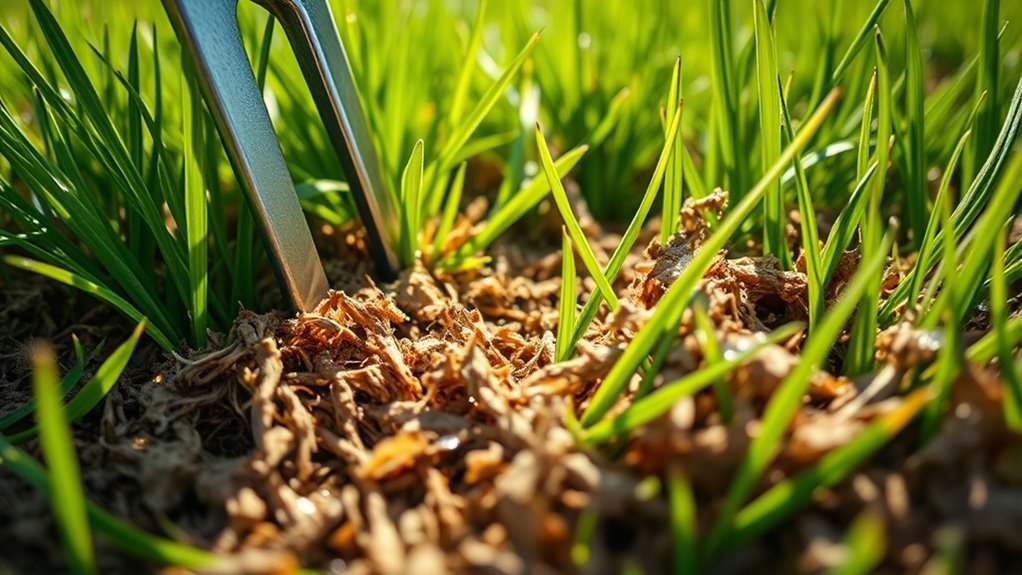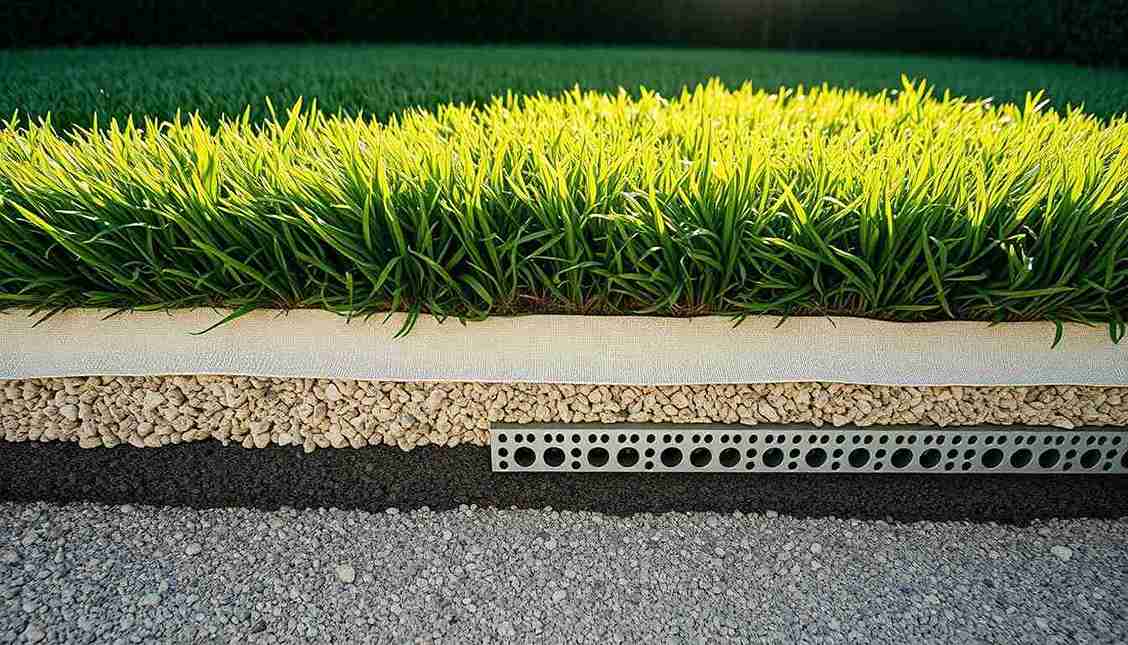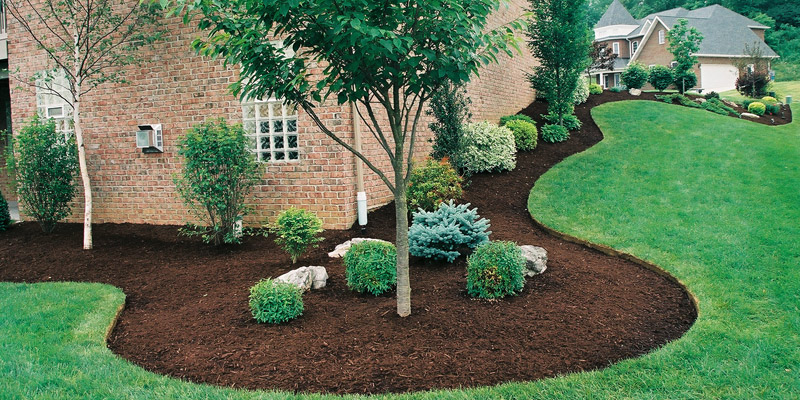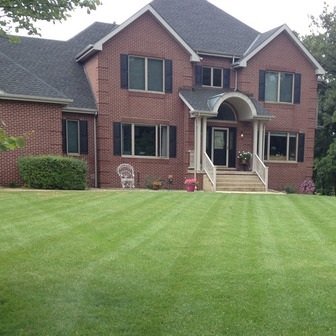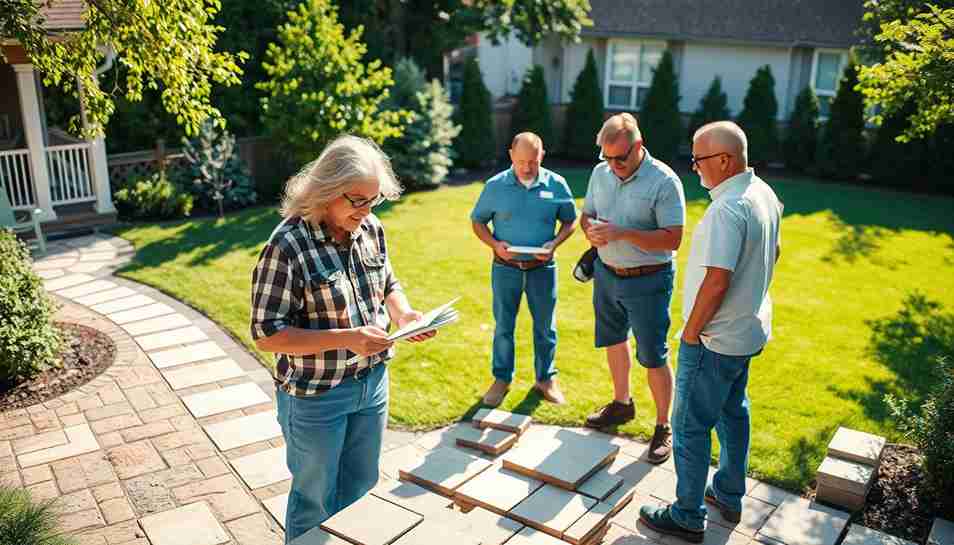Modern lawn sprinkler systems offer you smart, water-efficient solutions through AI-driven weather monitoring and zone-specific programming. You’ll reduce water consumption by up to 50% with features like automated scheduling, leak detection, and mobile connectivity. Top 2025 models include the Rachio 3 and Hunter Hydrawise HPC-400, which integrate with smart home platforms and real-time weather data. To optimize your system’s effectiveness, understanding key features and maintenance requirements will transform your irrigation strategy.
Essential Features of Modern Lawn Sprinklers
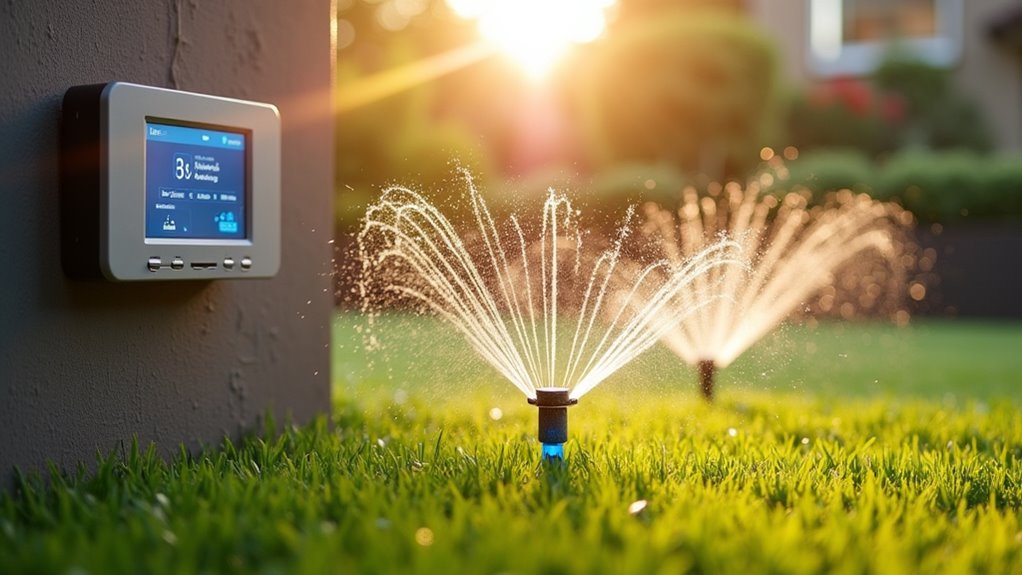
When selecting a modern lawn sprinkler system, several key features distinguish high-performing models from basic units. Today’s smart sprinkler controllers integrate weather data to adjust watering schedules automatically, optimizing water delivery based on rainfall, temperature, and humidity levels.
You’ll want to look for systems that offer zone-specific programming, allowing you to customize water distribution according to different plant types and soil conditions. Advanced models include flow sensors that detect leaks and automatically shut off affected zones, preventing water waste and alterations to the terrain.
The most efficient systems now incorporate mobile connectivity, enabling you to monitor and adjust settings remotely. Water efficiency features like pressure regulation and precision spray nozzles guarantee comprehensive coverage while minimizing runoff and evaporation, helping you maintain a healthy lawn while conserving resources.
Top Smart Sprinkler Systems for 2025
Smart sprinkler systems now integrate AI-driven weather monitoring and mobile connectivity to maximize your lawn’s hydration schedule based on real-time conditions. You’ll find advanced features like voice assistant compatibility in models such as the Rachio 3, while the Hunter Hydrawise HPC-400 offers expandability for larger properties requiring multiple zones. Weather-based watering technology automatically adjusts your irrigation schedule by analyzing local weather data, reducing water waste and ensuring ideal soil moisture levels throughout changing seasons.
Smart Technology Features Explained
Today’s leading smart sprinkler systems offer sophisticated automation and connectivity features that revolutionize lawn irrigation management. You’ll find these systems integrate seamlessly with smart home platforms while utilizing real-time weather data to optimize watering schedules. The technology adapts to your specific needs, ensuring efficient water usage.
| Feature | Basic Systems | Premium Systems | Professional Grade |
|---|---|---|---|
| Zones | 4-8 | 8-16 | Up to 32 |
| Weather Integration | Local Data | Advanced Forecasting | Predictive Analytics |
| Smart Home | Limited | Full Integration | Enterprise Control |
| Remote Control | Mobile App | Multi-User Access | Commercial Dashboard |
| Offline Operation | Basic Schedule | Smart Backup | Redundant Systems |
Advanced controllers like the Rachio 3 and Hunter Hydrawise offer expandable zone control, while systems like the B-hyve XR provide customizable notifications and account sharing for detailed property management.
Weather-Based Watering Benefits
As weather patterns become increasingly unpredictable, leading smart sprinkler systems in 2025 deliver exceptional water conservation through advanced weather-based algorithms.
You’ll optimize efficiency with controllers that tap into local weather data, like the Rachio 3, which responds dynamically to real-time weather conditions. This precision technology can reduce your water consumption by up to 50%. The Orbit B-Hyve’s weatherproof design guarantees reliable operation while providing intuitive control over your irrigation schedule.
For improved convenience, these systems integrate seamlessly with voice assistants, letting you adjust watering schedules remotely. While the Rain Bird ST8-2.0 may have connectivity challenges, its general performance remains strong. By leveraging weather-based watering technology, you’re not just saving water – you’re implementing a sophisticated solution that adapts to changing climate conditions and optimizes your lawn’s health.
Understanding Water Efficiency and Coverage
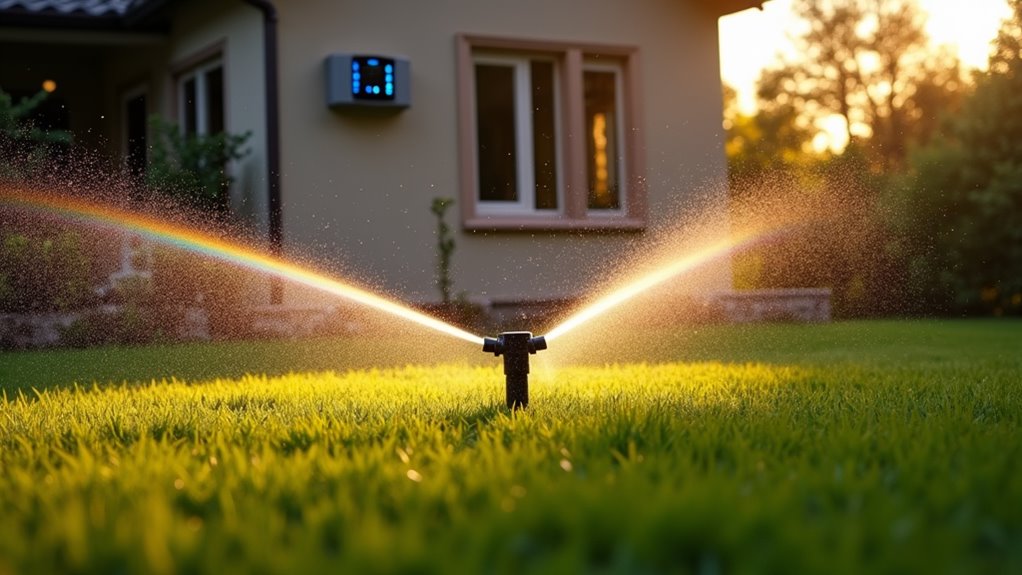
When selecting a lawn sprinkler system, understanding water efficiency and coverage patterns becomes crucial for maintaining a healthy terrain while minimizing waste. You’ll need to focus on uniform water distribution at lower precipitation rates to prevent runoff and conserve resources.
Your lawn irrigation success depends on selecting adjustable nozzles that let you modify water flow and spray patterns for different garden zones. You’ll achieve ideal coverage by ensuring your sprinkler design offers enough flexibility to address varying watering requirements across your landscape. This adaptability helps prevent common issues like waterlogging and dry patches.
Don’t forget to maintain your system regularly by checking nozzles for blockages. With proper setup and maintenance, you’ll avoid overwatering specific areas while ensuring efficient water usage throughout your lawn, ultimately reducing your water bills and improving the overall irrigation effectiveness.
Maintenance Tips for Long-lasting Performance
Regular maintenance serves as the bedrock of a reliable and efficient lawn sprinkler system. To optimize your system’s performance, you’ll need to conduct routine inspections of sprinkler nozzles, checking for dirt accumulation and mineral deposits that can impair water distribution.
Don’t overlook the importance of leak detection and pressure monitoring throughout your sprinkler system’s network. You’ll want to adjust water flow settings based on seasonal changes, amplifying output during hot periods and diminishing it when temperatures cool. Winterization is pivotal to avert freeze damage and safeguard your system’s longevity.
Smart Technology Integration and Controls
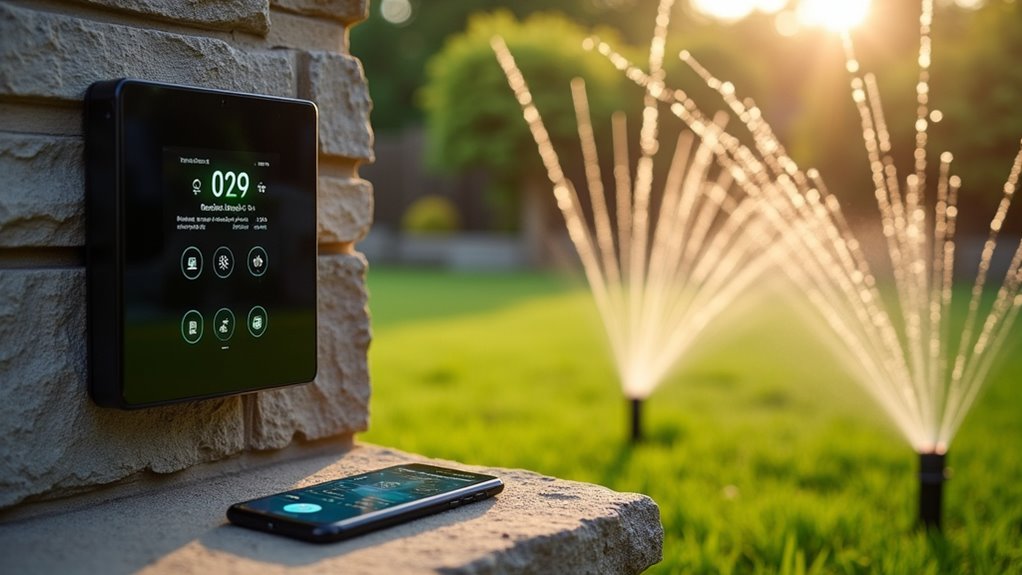
Modern smart controllers have revolutionized lawn irrigation by leveraging real-time weather data and advanced algorithms to maximize watering schedules. You’ll find these systems can automatically adjust to local conditions, helping you comply with water restrictions while maintaining ideal lawn health.
| Feature | Benefit | Impact |
|---|---|---|
| Weather Integration | Real-time adjustments | Reduced water waste |
| App Controls | Remote management | Improved convenience |
| Voice Commands | Hands-free operation | Simplified control |
When selecting a smart system, focus on the controller’s weather data integration capabilities, as this directly affects its ability to adjust watering patterns accurately. You’ll appreciate the flexibility of multiple control options, from manual adjustments to mobile apps and voice commands. These features not just streamline your irrigation management but also contribute to significant water savings on your utility bills.
Installation Considerations and Best Practices
A successful sprinkler system installation starts with thorough planning and precise measurements of your lawn’s dimensions. When considering irrigation systems, you’ll need to evaluate whether to pursue professional installation or DIY solutions based on your system type and expertise level.
Key installation considerations include:
- Water pressure requirements and connection points to your home’s main supply
- Proper zoning design to guarantee uniform coverage without overlap or dry spots
- Integration of terrain features and obstacles into your sprinkler arrangement
For in-ground sprinklers, professional installation is highly recommended to confirm proper trenching, component placement, and system integration. If you’re opting for above-ground systems, you’ll still need careful positioning and setup. Don’t forget to plan for winterization access points during installation, as proper seasonal maintenance will protect your investment long-term.
Seasonal Optimization Strategies
To optimize your sprinkler system’s performance year-round, you’ll need to adjust watering schedules according to each season’s specific demands. During spring, you should reduce watering frequency and duration to match lower evaporation rates, while summer requires increased watering cycles to combat intense heat and higher plant water needs. You’ll need to prepare for winter by thoroughly draining all system components to prevent freeze damage, ensuring your investment remains protected during the coldest months.
Spring Watering Schedule Adjustments
When spring temperatures begin rising, your lawn’s water requirements change noticeably, demanding careful adjustment of sprinkler schedules. Smart timers and weather reports help you make data-driven decisions about watering frequency, while regular soil moisture monitoring guarantees optimal water distribution.
To effectively manage your spring irrigation:
- Monitor local weather reports and reduce watering frequency during periods of natural rainfall
- Check soil moisture levels weekly using a moisture meter, adjusting run times based on readings
- Install smart timers that automatically modify schedules based on real-time weather conditions
As temperatures continue climbing through spring, you’ll need to gradually increase watering duration and frequency. Regular system inspections help identify leaks or malfunctioning components that could compromise water efficiency, ensuring your lawn receives precisely what it needs to thrive during this critical growth period.
Summer Heat Water Management
Summer’s intense heat and extended daylight hours demand strategic adjustments to your sprinkler system’s operation. To minimize water waste while maintaining lawn health, you’ll need to implement precise watering strategies that respond to elevated evaporation rates.
| Time Period | Action | Water Conservation Impact | Monitoring Method |
|---|---|---|---|
| Early Morning | Water 5am-7am | Minimal evaporation loss | Soil moisture sensor |
| Midday | Avoid watering | Prevents 30% water waste | Weather station data |
| Evening | Water 8pm-10pm | Reduced evaporation | Visual inspection |
| Overnight | System maintenance | Prevents leaks/overspraying | Controller diagnostics |
Install a smart controller that automatically adjusts watering schedules based on local weather conditions. You’ll maximize water efficiency by regularly inspecting sprinkler heads for proper coverage and adjusting run times according to soil moisture levels. This systematic approach guarantees effective water conservation while maintaining optimal lawn health during peak summer temperatures.
Winter System Protection Tips
Although winter’s freezing temperatures pose significant risks to sprinkler systems, proper winterization prevents costly damage and extends equipment longevity. In colder climates, you’ll need to guarantee no water system remains in your pipes before the initial freeze.
- Shut off the main water supply and activate the system to drain remaining water, paying special attention to low points where water could pool
- Use an air compressor to blow out all lines, maintaining pressure between 40-80 PSI to avoid damaging components
- Insulate above-ground components, including backflow preventers and exposed pipes, with foam covers or heat tape
Frequently Asked Questions
How to Choose the Right Sprinkler?
Preliminary, evaluate your lawn’s sprinkler coverage patterns by measuring the area and identifying different zones. You’ll need to match water pressure requirements with your home’s PSI rating – typically between 30-50 PSI for ideal performance. Consider a maintenance schedule that includes seasonal inspections and nozzle cleaning. Choose between rotary, spray, or impact heads based on your terrain’s shape, and don’t forget to factor in local water restrictions when selecting your system.
How Much Does an Irrigation System Increase Water Bill?
You’ll actually see a decrease in your water bill with a properly installed irrigation system. While seasonal water usage varies, you can expect 30-50% lower consumption compared to manual watering. Your lawn size considerations will impact total costs, but efficient sprinkler heads and smart controllers can save you up to $70 annually. The system pays for itself within 3-5 years through reduced water consumption, especially when you maintain it properly and fix leaks promptly.
Are Sprinkler Systems a Good Investment?
Yes, sprinkler systems are an excellent investment for your property. You’ll benefit from efficient water usage through automated scheduling and smart controls, potentially reducing your water bills by up to 50%. The cost-effective installation pays for itself through long-term savings and augmented property value. You’ll also enjoy significant landscaping benefits, including healthier grass and plants, while saving time on manual watering. Modern systems offer precise coverage and weather-responsive features that optimize your return on investment.
Is a Smart Sprinkler Controller Worth It?
Yes, a smart sprinkler controller is worth your investment. You’ll benefit from significant water conservation benefits, saving up to 50% on water usage through precise, weather-based scheduling. The smart home integration lets you control your system remotely via apps and voice commands. While installation considerations include Wi-Fi connectivity and compatibility with your existing system, the long-term savings on water bills and improved lawn health typically offset the initial cost.


